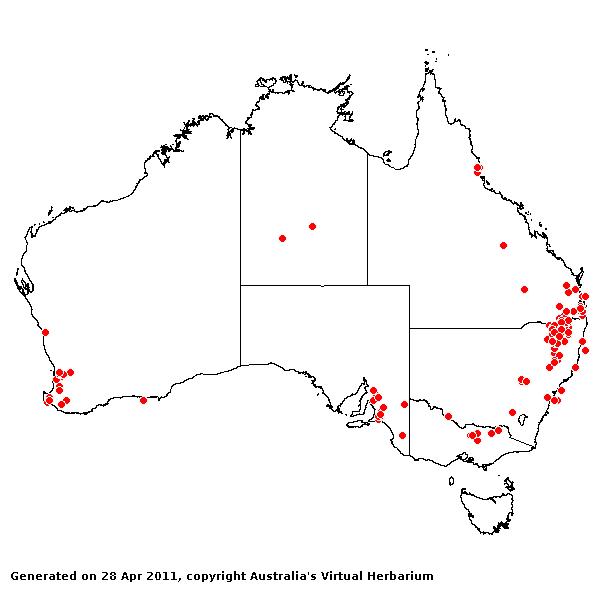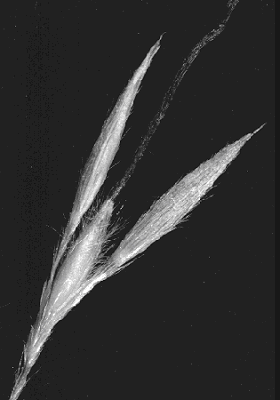Hyparrhenia hirta* (L.) Stapf. Fl.
Trop. Afr. 9: 315 (1919).
Classification. (GPWG 2001) : Subfamily
Panicoideae. Andropogoneae.
Basionym and/or
Replacement Name: Andropogon
hirtus L., Sp. Pl. 2: 1046 (1753).
Type of Basionym or
Protologue Information: LT: Burser I.119, (UPS). LT designated by
Sherif & Siddiqui, Fl. Libya 145: 310 (1889). ST: van Royen s.n.,
(L).
Recent synonyms:
H. quarrei.
Key references
(books and floras): [2002] D.Sharp & B.K.Simon, AusGrass, Grasses of
Australia, [2002] J.Wheeler, N.Marchant & M.Lewington, Flora of the
South West (421), [2006] J.Jessop, G.R.M.Dashorst, F.M.James, Grasses of
South Australia (523), [2008] S.W.L.Jacobs, R.D.B.Walley &
D.J.B.Wheeler, Grasses of New South Wales (282).
Illustrations:
[1984] N.T.Burbidge. rev. S.W.L.Jacobs, Australian Grasses (159), [2006] J.Jessop, G.R.M.Dashorst,
F.M.James, Grasses of South Australia (522, fig. 446), [2008] S.W.L.Jacobs,
R.D.B.Whalley & D.J.B.Wheeler, Grasses of New South Wales, 4th edn
(282).
Habit.
Perennial. Rhizomes present, short. Culms erect or geniculately ascending,
30–60(–100) cm tall, wiry. Leaves mostly basal. Ligule an eciliate membrane,
2–4 mm long. Leaf-blades flexuous, filiform or linear, flat or conduplicate,
2–30 cm long, 1–2(–4) mm wide. Leaf-blade surface scaberulous.
Inflorescence.
Inflorescence compound, composed of rames. Rhachis fragile at the nodes.
Spikelets.
Spikelets sessile, 1 in the cluster. Companion spikelets pedicelled, 1 in the
cluster. Basal sterile spikelets well-developed, 2 in number (lower raceme).
Companion spikelets developed, containing empty lemmas or male, 3–7 mm long.
Companion spikelet glumes muticous. Fertile spikelets 2-flowered, the lower
floret barren (rarely male), the upper fertile, comprising 1 basal sterile
florets, comprising 1 fertile floret(s), without rachilla extension, linear or
elliptic, dorsally compressed, 4–6.5 mm long.
Glumes. Glumes
dissimilar, firmer than fertile lemma. Lower glume lanceolate, hyaline or
coriaceous, without keels, 9 -nerved. Lower glume surface indumented. Upper
glume linear, hyaline or coriaceous, without keels. Florets. Basal
sterile florets 1, barren, without significant palea. Lemma of lower sterile
floret 100 % of length of spikelet, hyaline, 2 -nerved.
Fertile lemma without
keel, 1 -nerved. Lemma apex dentate, awned, 1 -awned. Median (principal) awn
from a sinus, 10–35 mm long overall, with a twisted column. Palea absent.
Lodicules present. Anthers 3.
Continental
Distribution: Europe, Africa, Temperate Asia, Tropical Asia, Australasia,
Pacific, North America, and South America.
Australian
Distribution: Western Australia, South Australia, Queensland, New South
Wales, Victoria.
Western Australia:
Irwin, Drummond, Dale. South Australia: Eastern, Northern Lofty,
Southern Lofty. Queensland: Burnett, Darling Downs, Maranoa, Moreton,
Cook. New South Wales: North Coast, North-Western Slopes,
Central-Western Slopes, North-Western Plains. Victoria: Riverina.
Notes. A
widespread species from the Mediterranean and NE tropical Africa through to
Pakistan and in South Africa with isolated records in tropical Africa.
Introduced to Australia where it is naturalised in northern and SE Qld, coastal
and northern N.S.W., S S.A., central N.T. and south-western W.A. Flowers
Mar.--Aug.






